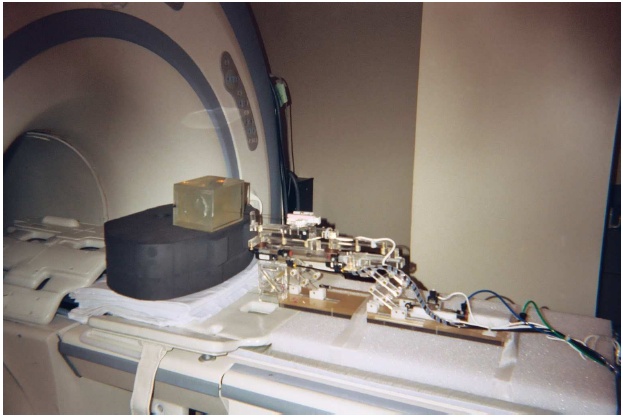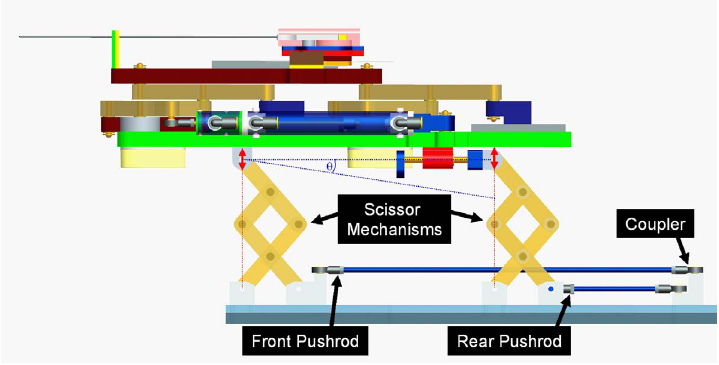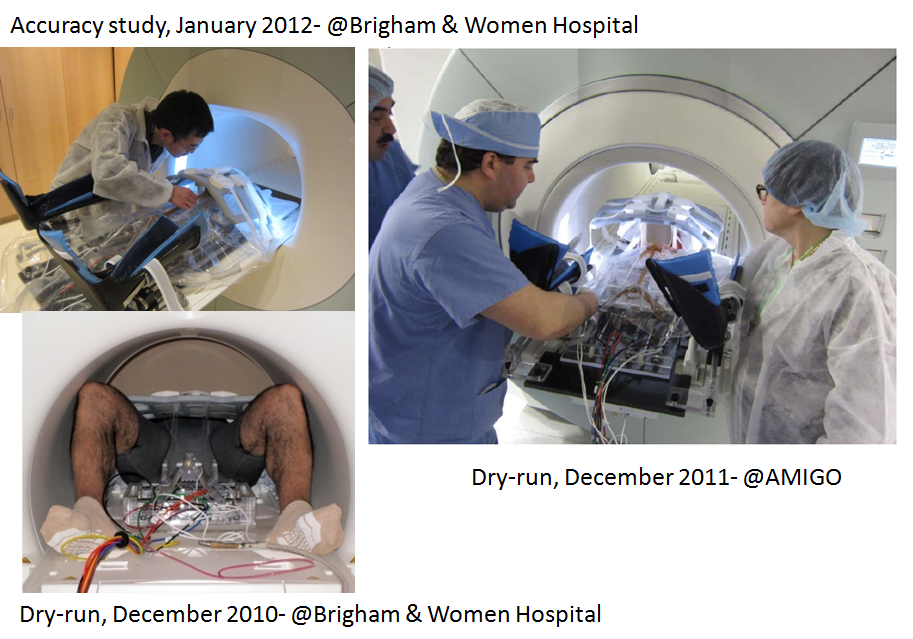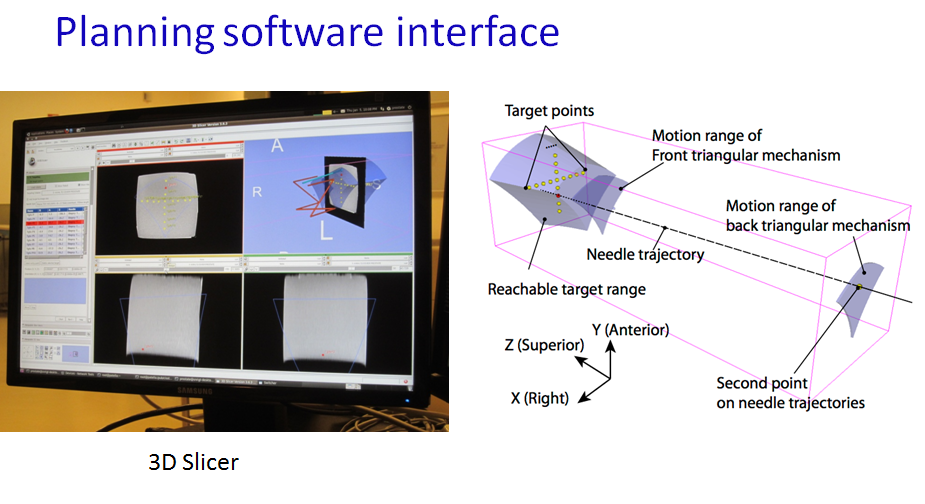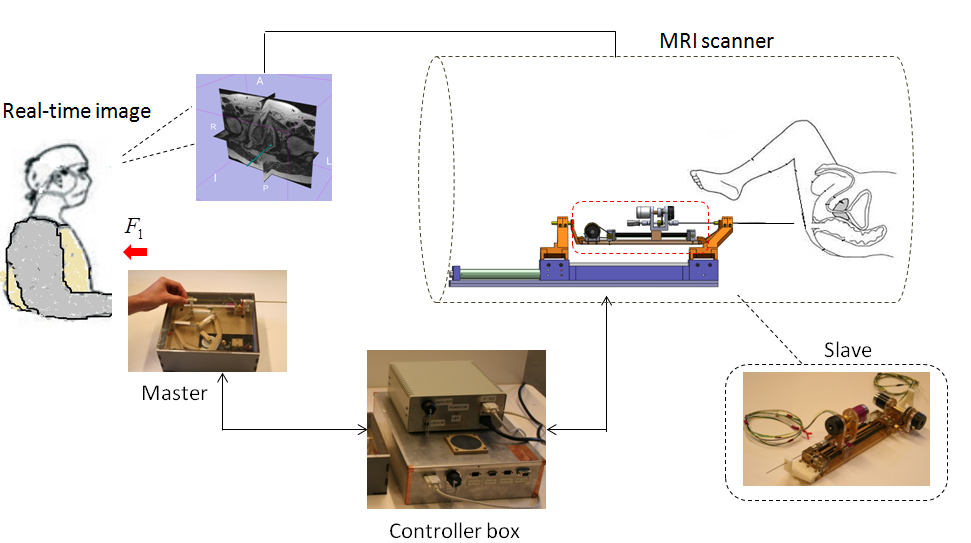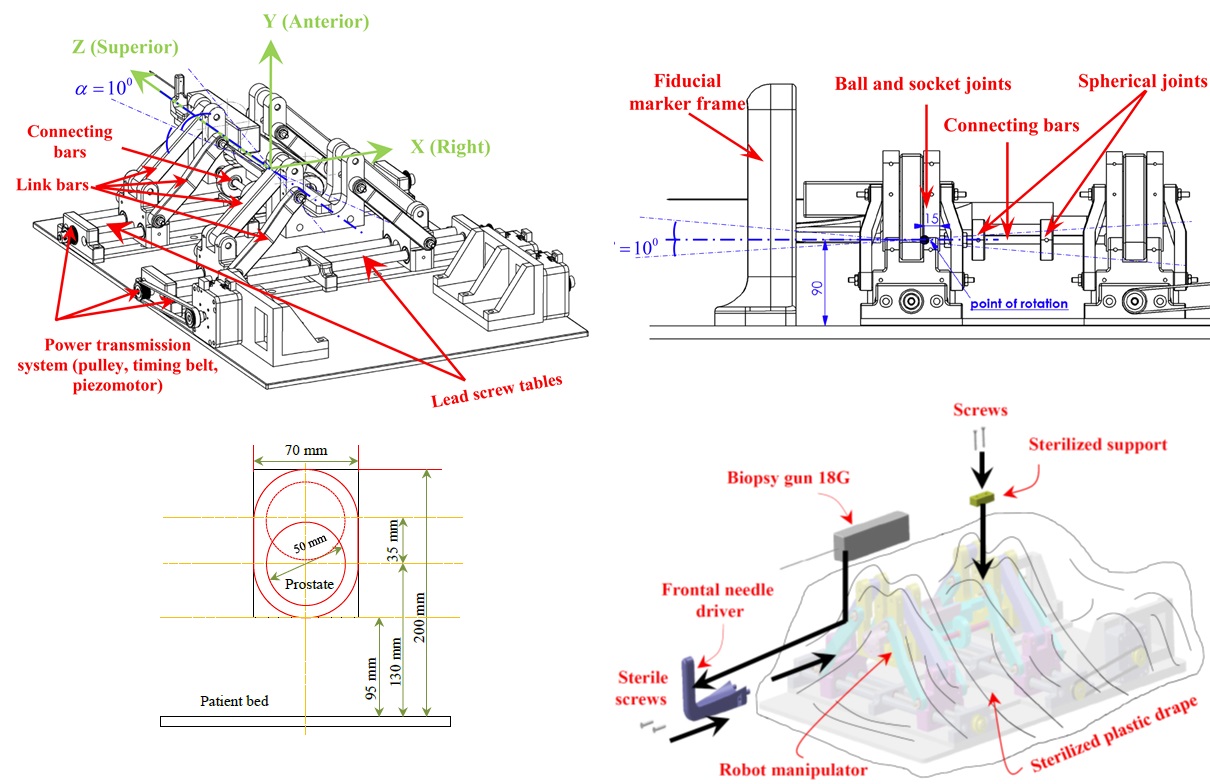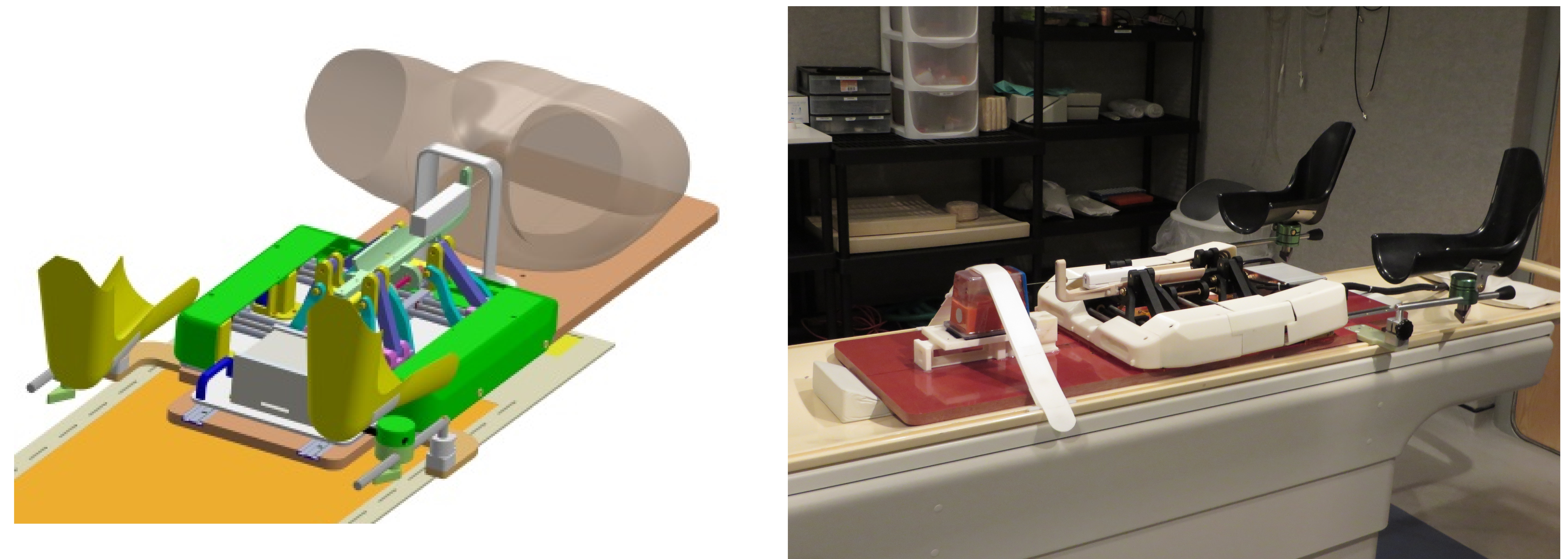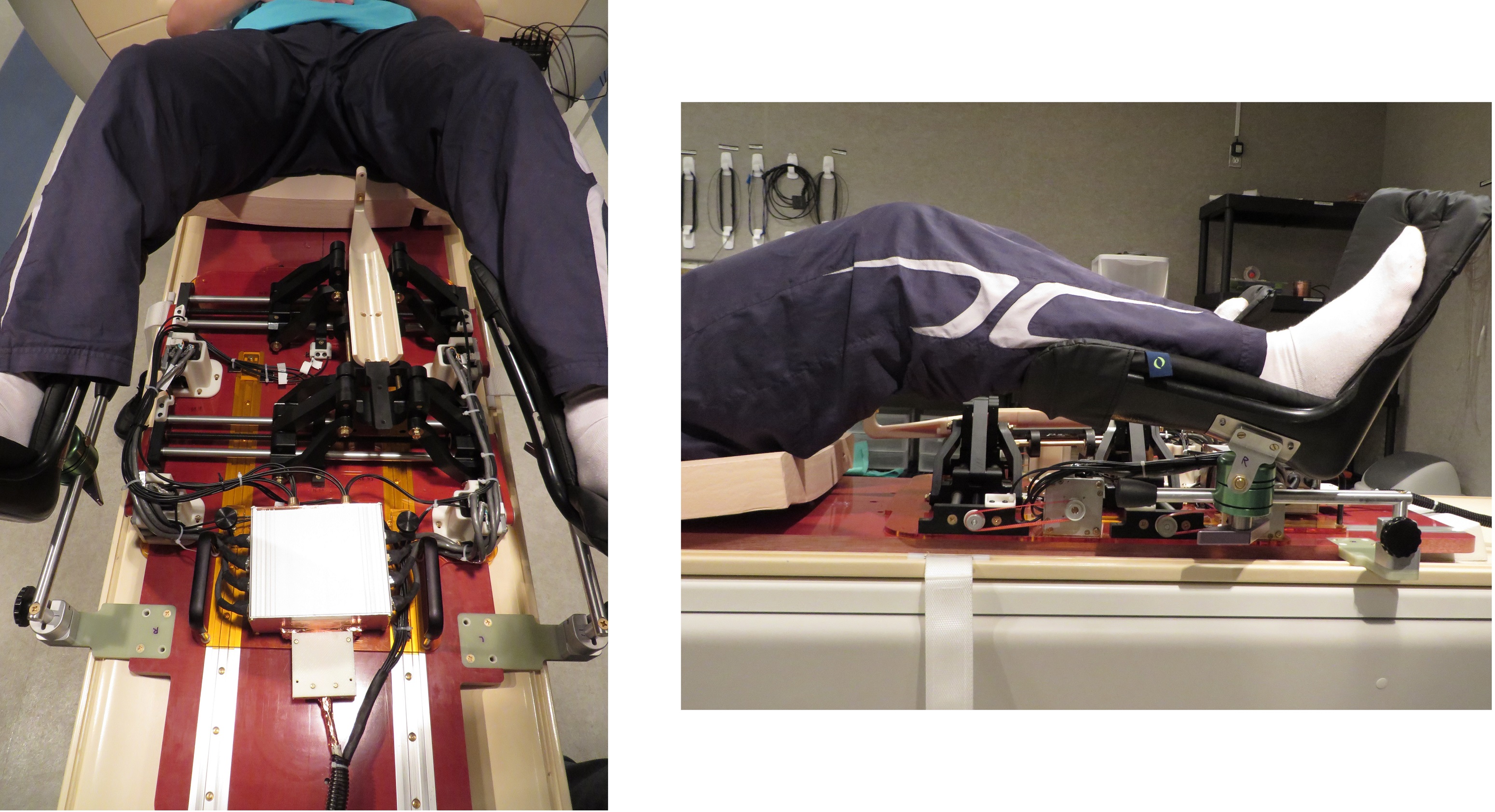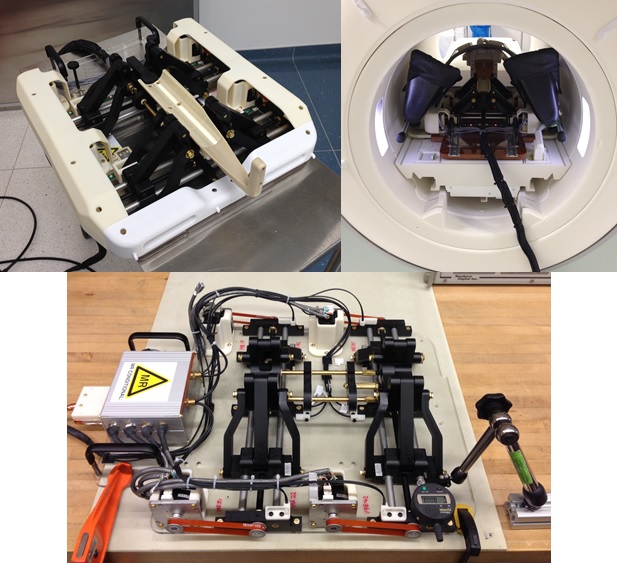Table of Contents
MRI Compatible Robotics
Problem
Prostate cancer is the most common male cancer in North America. MRI-guided prostate interventions (biopsy and brachytherapay) is proved to provide better results due to the superior image quality of MRI. Up to date, a handful of robotic systems have been introduced to assist manual MRI-guided percutaneous prostate needle placement. These systems range from fully manual systems to fully actuated systems. However, no system has been able to meet all clinical requirements mainly due to insufficient system integration with MRI and exclusion of clinicians from the procedure by taking autonomous approach in robot design. Hence, a clinically approved MRI-compatible assistant robot which can perform prostate intervention more accurately and reliably with less trauma to patient is highly in demand.
Solution
So far, we have developed two versions of pneumatic robot for MRI-guided needle placement. Figure 1 shows the firs robot prototype with two scissor mechanisms in horizontal and vertical plane. Unlike the standard manual procedure in which a grid of template is used to guide surgical needles, the robot can also provide yaw and pitch angulation in order to cover the entire prostate capsule and also to avoid pubic arc/urethra interference.
Figure 1. The first robot manipulator consisting of two scissor mechanisms while doing phantom experiment (left side). Vertical scissor mechanism (right side)
Due to the high actuation force required to move the robot which can negatively affect robot accuracy as well, a parallel kinematic architecture was designed later as shown in Figure 2. The pyramid shape of the robot will optimally use the space under the patient's legs.
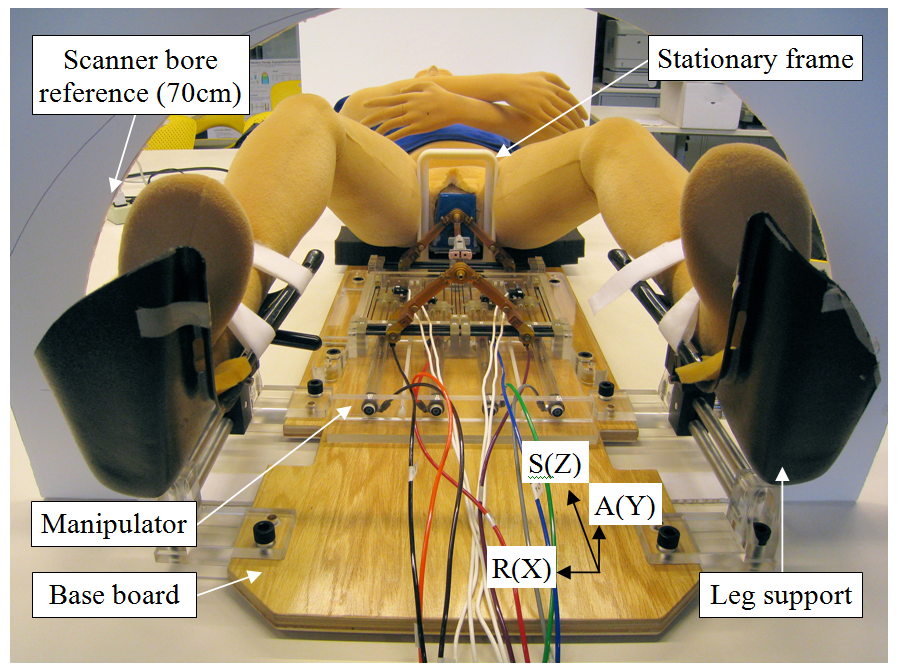
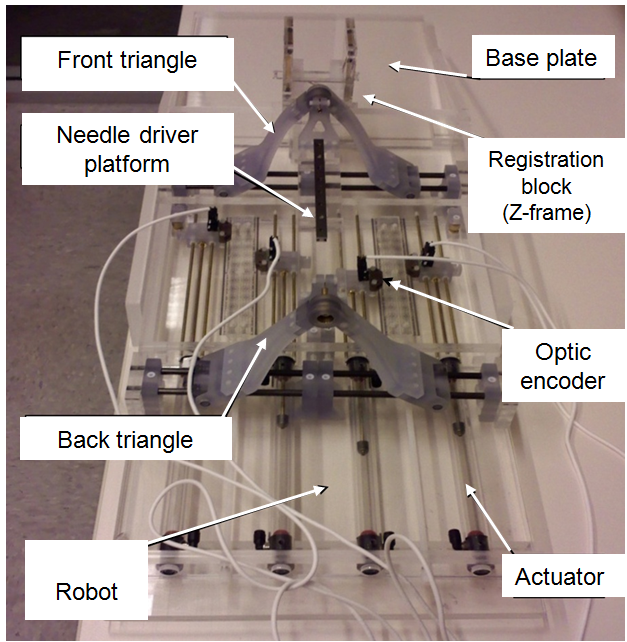
Figure 2. The second robot manipulator- a 4-DOF parallel manipulator- while doing phantom experiment (left side). Robot closeup view (right side)
System Components
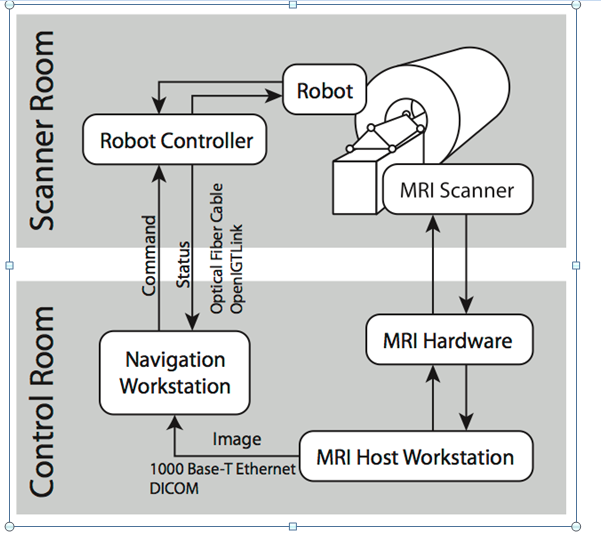 Figure 3. Diagram of system components and information flow. Red sharp rectangles are explained in future plan
Figure 3. Diagram of system components and information flow. Red sharp rectangles are explained in future plan
In MR suite (Figure 3), the patient, the robot and the robot controller are placed. The pneumatic robot needs air to run; hence, the controller is connected to the medical air supply which is available in hospital. The controller sends the commands to the robot and gets position feedback from the robot optical encoders. The DC power is transmitted through the patch panel which is an Electro Magnetic (EM) filtered panel specifically designed for this reason in MR room. In the control suite(right hand side), there is scanner console to control the MRI machine. There is another workstation on which 3D Slicer (http://www.slicer.org/) is installed and named as “planning workstation”. 3D Slicer is an interface between the scanner console and robot controller as robot controller cannot directly communicate with scanner console. In 3D Slicer, prostate image is downloaded from scanner console. Target positions are selected by clinician in this software and sent as commands to the robot controller. A local network should therefore be established among the planning workstation, scanner console and the robot controller.
Results
The robot performance is evaluated in terms of MRI compatibility, targeting accuracy and clinical workflow feasibility.
- MRI compatibility: for MRI compatibility, the robot and EM shielded controller were placed in scanner room. The MRI image of the standard spherical phantom in the presence of the system showed negligible image artifact without noticeable SNR degradation.
- robot accuracy: the manipulator-only accuracy has been evaluated using Optotrack after robot calibration. The average error was 1.82 mm with a STD=1.18 mm. The Z-frame registration to MRI was investigated separately and the average error was 1.5 mm with STD=1.2 mm. The overall system accuracy (including the manipulator error, registration error, needle deflection) will be evaluated in phantom experiment.
- clinical workflow and sterilization: the clinical workflow as well as robot sterilization using the robotic system described in Figure 3 has been established and rehearsed a few times in phantom experiment. The results showed feasibility of the robotic approach for clinical use.
- Future Plans: At the moment, we are implementing tele-operated needle insertion capability to the current version of the robot in order to eliminated many in-and-out moves of the patient during the biopsy procedure and consecuently shortening the procedure and providing more comfort to the patient. The first prototype of this module is single DOF without haptic feedback (for more details, see IJCARS 2011 or Song 2011). Next step is to make the system bilateral with adding FBG force sening thus providing force feedback on the operator's hand.
Third generation of the robot
In the third prototype of such robotic system, we have designed and developed a minimally invasive surgical manipulator for MRI-guided transperineal prostate interventions. The proposed manipulator takes advantage of 4 sliders actuated by the MRI compatible piezomotors and rotary encoders. Severe constraints for the MRI-compatibility to hold the minimum artifact on the image quality and dimensions restraint of the bore scanner shadow the design procedure. Regarding the constructive design, the manipulator kinematics has been optimized and the effective analytical needle workspace is developed and followed by proposing the workflow for the manual needle insertion. The introduced robotic manipulator herein is aimed for the clinically prostate biopsy and brachytherapy applications. Here are the summary of the anticipated robot specifications:
• 4 actuated DOF (X, Y, Rx, Ry) • Range of motion: X= ± 35 mm; Y = 130±35 mm, Rx, Ry = ±10° • Resolution of the robot’s motion 0.1 mm or better • Robot can travel through its range of motion within 30 seconds • Accuracy at the needle’s tip in air ±0.5 mm or better, in X-Y plane • Needle insertion’s accuracy at the needle’s tip in air ± 1.5 mm or better • Sufficient stiffness and no backlash • Modular design for manual and tele-operated needle insertion • Compliance with clinical workflow and safety regulations
Results
The robot’s accuracy, repeatability, and MRI compatibility have been evaluated resulting in sustainability and precision of the robot:
Project personnel
- Posdoc
- Reza Seifabadi (Joseph E. Robert Fellow at Children's National Medical Center, Washington, DC)
- Sam Song (now research scientist at SPL)
- Sohrab Eslami (Postdoc research fellow at Johns Hopkins University)
- Research Engineer
- Nathan Cho (at JHU)
- Faculty
- Prof. Clare Tempany (Harvard Medical School)
- Prof. Gabor Fichtinger (Queens University)
- Prof. Iulian Iordachita (Johns Hopkins)
- Prof. Nobuhiko Hata (Harvard Medical School)
- Dr. Junichi Tokuda (Harvard Medical School)
- Prof. Gregory Fischer (Worcester Polytechnic Institute)
Funding
- NIH # 5R01CA111288-04
- NIH #5R01EB002963-05
- NIH #5P01CA067165
- NIH #5U41RR019703
Affiliated Labs/company
Publications
- 2013
- [Eslami2013] S. Eslami, G.S. Fischer, S.E. Song, J. Tokuda, N. Hata, C.M. Tempany, and I. Iordachita, “Towards Clinically Optimized MRI-guided Surgical Manipulator for Minimally Invasive Prostate Percutaneous Interventions: Constructive Design”, 2013 IEEE International Conference on Robotics and Automation (ICRA), Karlsruhe, Germany, May 6-10, 2013.
- 2012*
- [Seifabadi2012c] R. Seifabadi, I. Iordachita, and G. Fichtinger, “Towards teleoperated needle steering in MRI-guided prostate interventions”, 9th Interventional MRI Symposium, Sep 2012, Boston, USA
- [Escobar2012a] Escobar , R. Seifabadi, G. Fichtinger, and I. Iordachita, “Real-time needle tip tracking using Fiber Brag Grating sensors for MRI-guided prostate interventions: Design considerations”, 9th Interventional MRI Symposium, Sep 2012, Boston, USA
- [Seifabadi2012b] Seifabadi R, Iordachita I, and Fichtinger G, “Teleoperated needle steering under MRI guidance for prostate interventions: design challenges”, IEEE BioRob 2012, In Press
- [Tokuda2012b] J. Tokuda, S.E Song, G. Fischer, I. Iordachita, R. Seifabadi, BJ. Cho, G. Fichtinger, C. M. Tempany, and N. Hata, “Preclinical evaluation of MRI-compatible pneumatic robot for angulated needle placement in prostate interventions”, International Journal of Computer Aided Radiology and Surgery (IJCARS), Accepted 08-May-2012, Springer
- [Song2012] Song SE, Hata N, Iordachita I, Fichtinger G, Tempany CM, Tokuda J. “A Workspace-oriented Needle Guiding Robot for 3T MRI-guided Transperineal Prostate Intervention: Evaluation of In-bore Workspace and MRI Compatibility”, The International Journal of Medical Robotics and Computer Assisted Surgery (IJMRCAS)
- [Tokuda2012a] Tokuda J, Song SE, Fischer G, Iordachita I, Seifabadi R, Cho N BJ, Fichtinger G, Tempany CM, Hata N.“Preclinical evaluation of MRI-compatible pneumatic robot for angulated needle placement in prostate interventions”, Computer Aided Radiology and Surgery (CARS) 2012, Italy
- [Seifabadi2012a] Seifabadi R, Cho N BJ, Song SE, Tokuda J, Hata N, Tempany CM, Fichtinger G, Iordachita I. “Acuracy Study of a MRI-guided Robotic System for Prostate Biopsy”, Accepted Apr-05-2012, International Journal of Medical Robotics and Computer Assisted Surgery (IJMRCAS), In Press
- 2011*
- [Seifabadi2011] Seifabadi R, Song S, Krieger A, Cho N BJ, Tokuda J, Fichtinger G, Iordachita I. “Robotic System for MRI-guided Prostate Biopsy: Feasibility of Teleoperated Needle Insertion and ex vivo Phantom Study”, International Journal of Computer Aided Radiology and Surgery (IJCARS), In Press.
- [Song2011] Song S, Seifabadi R, Krieger A, Tokuda J, Fichtinger G, Iordachita I “Robotic System for MRI-guided Prostate Intervention: Feasibility Study of Teleoperated Needle Insertion”, CARS 2011, Berlin, Germany
- [Tokuda2011] Tokuda J, Tuncali K, Iordachita I, Song S S-E, Fedorov A, Oguro S, Lasso A, Fennessy FM, Tang Y, Tempany CM et al.. In Press. Preliminary Accuracy Evaluation of 3T MRI-guided Transperineal Prostate Biopsy with Grid Template. ISMRM 2011.
- [Tuncali2011] Tuncali K, Tokuda J, Iordachita I, Song S S-E, Fedorov A, Oguro S, Lasso A, Fennessy FM, Tang Y, Tempany CM et al.. In Press. 3T MRI-guided Transperineal Targeted Prostate Biopsy: Clinical Feasibility, Safety, and Early Results. ISMRM 2011.
- 2010
- [Gao2010] Gao, Y, Sandhu R, Fichtinger G, Tannenbaum A R. 2010. A Coupled Global Registration and Segmentation Framework With Application to Magnetic Resonance Prostate Imagery. IEEE Transactions on Medical Imaging. 29(10):1781-1794.
- [Song2010c] Song S, Cho N B, Tokuda J, Hata N, Tempany CM, Fichtinger G, Iordachita I. 2010. MRI compatibility study of a pneumatically actuated robotic system for transperineal prostate needle placement. CARS 2010 - Proceedings of the 24th International Congress and Exhibition. Int J CARS Vol 5 (Suppl 1):26-27.
- [Song2010c] Song S, Cho N B, Iordachita I, Fischer G, Tokuda J, Hata N, Fichtinger G, Tempany CM. 2010. Development of a Pneumatic Robot for MRI-Guided Transperineal Prostate Intervention. Proc. of International Society for Magnetic Resonance in Medicine (ISMRM 2010).
- [Song2010b] Song, S, Cho N B, Tokuda J, Hata N, Tempany CM, Fichtinger G, Iordachita I. 2010. MRI compatibility study of a pneumatically actuated robotic system for transperineal prostate needle placement. 3rd Annual Image-Guided Therapy Workshop.
- [Song2010a] Song, S, Cho N B, Fischer G, Hata N, Tempany CM, Fichtinger G, Iordachita I. 2010. Development of a Pneumatic Robot for MRI-guided Transperineal Prostate Biopsy and Brachytherapy: New Approaches. IEEE International Conference on Robotics and Automation, ICRA 2010. :2580-2585.
- 2008
- [Fischer 2008] Fischer GS, Iordachita I, Csoma C, Tokuda J, DiMaio SP, Tempany CM, Hata N, Fichtinger G, MRI-Compatible Pneumatic Robot for Transperineal Prostate Needle Placement, IEEE / ASME Transactions on Mechatronics – Focused section on MRI Compatible Mechatronic Systems, Vol 13, No 3, pp 295-305, June 2008.
- [Tokuda 2008] Tokuda J, Fischer GS, Csoma C, DiMaio SP, Gobbi DG, Fichtinger G, Tempany C, Hata N, Software Strategy for Robotic Transperineal Prostate Therapy in Closed-Bore MRI, 11th International Conference on Medical Image Computing and Computer-Assisted Intervention - MICCAI 2008, New York, NY, Lecture Notes on Computer Science, Vol 5242, pp 701-709, Springer, September 2008.
- [Tokuda2008] Tokuda, J, DiMaio S, Fischer G, Csoma C, Gobbi D, Fichtinger G, Hata N, Tempany C. 2008. Real-time MR Imaging Controlled by Transperineal Needle Placement Device for MRI-guided Prostate Biopsy. 16th Scientific Meeting and Exhibition of International Society of Magnetic Resonance in Medicine.
- [Fischer 2008] Fischer GS, Iordachita I, Csoma C, Tokuda J, Mewes PW, Tempany CM, Hata N, Fichtinger G, Pneumatically Operated MRI-Compatible Needle Placement Robot for Prostate Interventions, International Conference on Robotics and Automation - ICRA 2008, Pasadena, CA, pp 2489-2495, May 2008.
- [Mewes2008] Mewes, P, Tokuda J, DiMaio S, Fischer G, Csoma C, Gobbi D, Tempany C, Fichtinger G, Hata N. 2008. Integrated system for robot-assisted in prostate biopsy in closed MRI scanner. Procedings IEEE International Conference on Robotics and Automation ICRA 2008. :2959–2962.
- 2007
- [Fischer 2007] Fischer GS, Iordachita I, DiMaio SP, Fichtinger G, Development of a Robotic Assistant for Needle-Based Transperineal Prostate Interventions in MRI, 10th International Conference on Medical Image Computing and Computer-Assisted Intervention - MICCAI 2007, Brisbane, Australia, Lecture Notes on Computer Science, Vol 4791, pp 425-433, Springer, November 2007.
- 2006
- [Fischer 2006] Fischer GS, Iordachita I, DiMaio SP, Fichtinger G, Design of a Robot for Transperineal Prostate Needle Placement in an MRI Scanner, IEEE International Conference on Mechatronics - ICM 2006, Budapest, Hungary, July 2006.
- [DiMaio 2006] DiMaio SP, Fischer GS, Haker SJ, Hata N, Iordachita I, Tempany CM, Fichtinger G, System for MRI-guided Prostate Interventions, IEEE International Conference on Biomedical Robotics and Biomechatronics - BioRob 2006, Pisa, Italy, February 2006.
- [Fischer 2006] Fischer GS, DiMaio SP, Iordachita I, Fichtinger G, Robotic Assistant for MR-guided Prostate Biopsy, 6th Interventional MRI Symposium, Leipzig, Germany, September 2006.
- [DiMaio2006] DiMaio, S, Fischer G, Haker S, Hata N, Iordachita I, Tempany C, Fichtinger G. 2006. Design of a Prostate Needle Placement Robot in MRI Scanner. IEEE International Conference on Biomedical Robotics.
- [Fischer2006] Fischer, G, DiMaio S, Iordachita I, Fichtinger G. 2006. Robotic MRI-guided Prostate Needle Placement. Medical Robotics workshop to the 9th MICCAI Conference.

